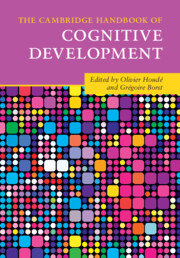Book contents
- The Cambridge Handbook of Cognitive Development
- The Cambridge Handbook of Cognitive Development
- Copyright page
- Contents
- Figures
- Tables
- Contributors
- Introduction
- Part I Neurobiological Constraints and Laws of Cognitive Development
- Part II Fundamentals of Cognitive Development from Infancy to Adolescence and Young Adulthood
- Introduction
- Subpart II.1 Infancy: The Roots of Human Thinking
- Subpart II.2 Childhood and Adolescence: The Development of Human Thinking
- 15 Development of Qualitative Thinking
- 16 Development of Numerical Knowledge
- 17 Numerical Cognition and Executive Functions
- 18 Developing Theory of Mind and Counterfactual Reasoning in Children
- 19 Development of Executive Function Skills in Childhood
- 20 Developing Cognitive Control and Flexible Adaptation during Childhood
- 21 Reasoning Bias and Dual Process Theory
- 22 Social Cognitive Development
- 23 Behavioral and Neural Development of Cognitive Control and Risky Decision-Making across Adolescence
- 24 The Triadic Neural Systems Model through a Machine-Learning Mill
- Part III Education and School-Learning Domains
- Index
- Plate Section (PDF Only)
- References
22 - Social Cognitive Development
The Intergroup Context
from Subpart II.2 - Childhood and Adolescence: The Development of Human Thinking
Published online by Cambridge University Press: 24 February 2022
- The Cambridge Handbook of Cognitive Development
- The Cambridge Handbook of Cognitive Development
- Copyright page
- Contents
- Figures
- Tables
- Contributors
- Introduction
- Part I Neurobiological Constraints and Laws of Cognitive Development
- Part II Fundamentals of Cognitive Development from Infancy to Adolescence and Young Adulthood
- Introduction
- Subpart II.1 Infancy: The Roots of Human Thinking
- Subpart II.2 Childhood and Adolescence: The Development of Human Thinking
- 15 Development of Qualitative Thinking
- 16 Development of Numerical Knowledge
- 17 Numerical Cognition and Executive Functions
- 18 Developing Theory of Mind and Counterfactual Reasoning in Children
- 19 Development of Executive Function Skills in Childhood
- 20 Developing Cognitive Control and Flexible Adaptation during Childhood
- 21 Reasoning Bias and Dual Process Theory
- 22 Social Cognitive Development
- 23 Behavioral and Neural Development of Cognitive Control and Risky Decision-Making across Adolescence
- 24 The Triadic Neural Systems Model through a Machine-Learning Mill
- Part III Education and School-Learning Domains
- Index
- Plate Section (PDF Only)
- References
Summary
Throughout human history and across all human cultures, civilizations have organized themselves into social collectives, to the extent that it seems fair to say that social groups are the natural ecology of our species. In many ways, these groups play the same role as do categories in other domains; after all, the world is an incredibly complex place, and dividing it into categories is a powerful way to simplify this complexity and maximize efficiency in learning. In the social world, this way of working through complexity is especially important, given the extreme range of variability that exists across human individuals and communities. Children must navigate a world full of people with a range of properties that appear to have little in common with one another, posing a particularly difficult learnability problem. Social categorization allows children to work through this complexity by selecting features that denote meaningful differences between people (see Chapter 13). As a result, social categories become a fundamental lens through which we see the world.
- Type
- Chapter
- Information
- The Cambridge Handbook of Cognitive Development , pp. 481 - 499Publisher: Cambridge University PressPrint publication year: 2022
References
- 2
- Cited by



